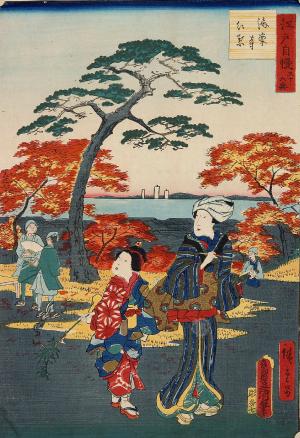Thirty-six Views of Pride of Edo-tinged autumn leaves in the Kaian-ji Temple (Edo Jiman Sanjūrokkyō Kaian-ji no Momiji)
Painted by Utagawa Toyokuni III and Utagawa Hiroshige II 1864 (Genji 1) Tokyo Shiryō Collection 3556-C1
Kaian-ji, the Sōtō sect temple Fudarakusan of Samezu in Shinagawa is a notable spot for autumn leaves viewing and it attracts many visitors around late autumn. In this illustration, the figure of a mother with her child enjoying the autumn leaves is depicted.
Kaian-ji Temple is located in Shinagawa, the foremost inn town of the Tōkaido Highway, and is the prime temple for viewing autumn leaves. A Kannon statue was found from a shark's abdomen caught by the nets of Shinagawa fishermen and so it was enshrined by building a temple under the order of the ruler of the day, Tokiyori Hōjō, in 1251 (3rd year of Kenchō), and this was the beginning of the temple and one of the reasons the area became known as Samezu ('shark province').
As suggested by the name for the tenth month of the lunar calendar, Kanna-zuki (the month where the gods are absent), the deities of Japan were believed to have left for Izumo and possibly as a result of this, there were few festivals in Edo city during that month and the people would head out towards spots which offered fine views of the autumn leaves. In the spacious garden of Kaian-ji Temple, there is a tea house built to view the leaves and the temple attracted many day trippers.
A mother and child are depicted on the surface, but autumn leaves viewing was not such a popular activity with children, young people and ladies and instead was more popular among men of letters such as haiku and renga poets, doctors and priests and it was said to be the pastime of adults.


